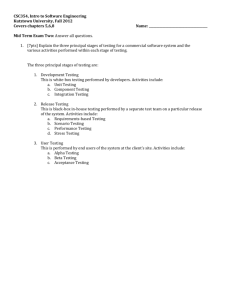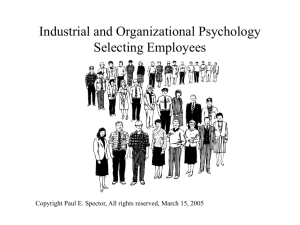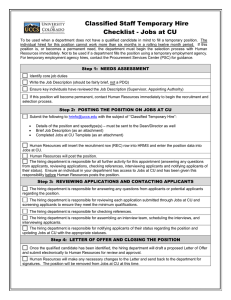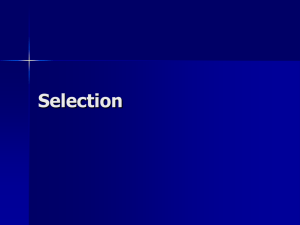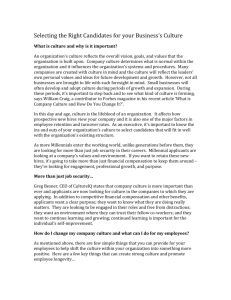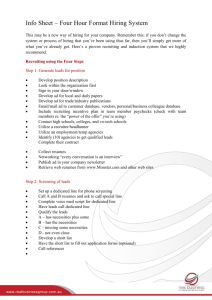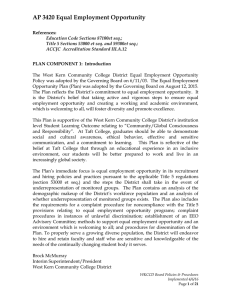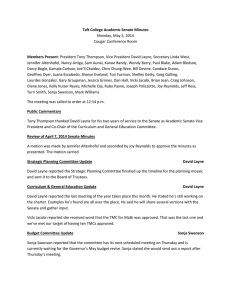Chapter #5…….Selection and Testing
advertisement
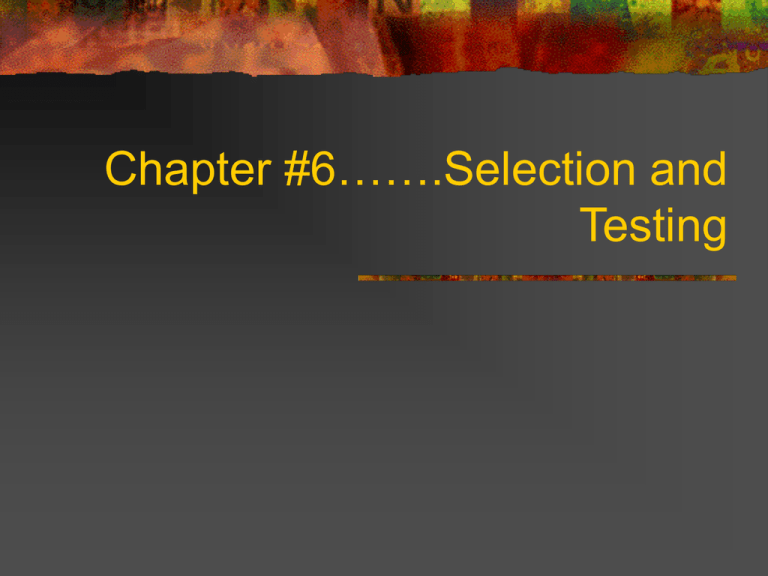
Chapter #6…….Selection and Testing Why careful Selection? Your performance depends upon the strength of your team members Cost $112,000 /position filled Legal implications EEO laws Negligent hiring EEO Laws apply to all selection devices Interviews Applications References Background checks Negligent Hiring and Retention 18.7% have lied about their criminal record 14.8% lied about their workers’ comp 29.6% Misrepresent their education 25% Misrepresent employment history 33% will steal from er this year 30% of all small business failures due to ee theft Annual cost of theft and fraud is 4 billion 53% of applications contain falsehoods 23% have wrong SSI numbers 71% of all drug abusers have jobs Workplace violence costs over 36 billion yearly this in an increase of 850% In the last five years How to eliminate negligent hiring Recruitment Job analysis Know job and job specs Do not exaggerate jobs Show job descriptions to applicants Turnover costs Discipline costs Disruption Lost customers Training Lost productivity and reduced morale Validity Test validity Criterion validity Tests scores predict job performance Content validity Tests contain a sample of the skills needed on job Testing conditions should resemble the real job. Look #128 How do you interpret this picture> Reliability The consistency of scores Test retest reliability Equivalent form estimate GRE, SAT is an example Internal consistency To measure a persons abilities by several different measures or questions. How do you validate a Test? Analyze the job Choose the Tests Administer the test Relate your test scores to the criterion. (job performance) Expectancy charts #131 Shows relationship between the test scores and job performance. Expectancy Charts #131 CROSS VALIDATE AND REVALIDATE Try it out a few times. Types of Testing procedures Computer-interactive testing. Intelligence testing Specific Cognitive Abilities Stanford Binet, Wechsler, Nonverbal intelligence Mechanical Reasoning Test Physical and Motor Abilities Crawford Small Part Dexterity Tests Minnesota Manipulation Tests Personality and Interest Tests MBTI Tests cont Work Sample Tests Management assessment centers Actual jobs tasks (welding) Applicants are put in hypothetical situations Video-Based Situational Testing Miniature Job Training and Evaluation Approach Train and then evaluate performance after training Tests Brainbench.com Wonderlich.com Stanford-Binet .com Wechsler.com Document, document, document Your best defense All paperwork Make sure all forms are complete or do not accept them Do applicants have too many excuses? Crosscheck all information on application with resume. Get release forms signed 1-9 forms IRCA Substance abuse release Searches Social Security Report Criminal Records Reveals felonies and misdemeanors County, State and Federal History Social Security Number National Warrants Civil records Credit Reports Motor Vehicle Report Education Verification Prior employment Military records Professional License verification Worker’s comp (post hiring/ADA) Medicaid Sanctions Child or elder care abuse Should You Use A Service? OK but Be Careful ADA prohibits delving into disabilities Asking about comp claims Theft Theftnet..has names of workers who have signed admissions that they stole Only use information that is job related Keep it confidential an up to date Never authorize an unreasonable investigation. How to find a employment screening provider www.workforce.com to look at a list of screening companies www.publicrecordsources.com more leading screening companies www.uwex.edu/ces/cced/publicat/turn.html How to calculate turnover costs The Issue of Privacy The federal Privacy Act gives federal ees the right to inspect their files and limits the disclosure of personnel information without employee’s consent. Need to know rule Defamation 15% - 20% of applicants try to hide something Fair Credit and Reporting Act 1970 You can see reports You are given time to check. You can sue for defamation Background Investigations 95% US Corps do checks Driving record Criminal charges Credit worthiness Law suits Education history Past employment Neighbors, coworkers Giving References? Know the law. Privacy Act of 1974 Fair Credit Reporting Act l970 Family Education Rights and Privacy Act Freedom of Information ACt You must report dangerous behavior Laws say you have a right to know your information Don’t volunteer anything Dates of employment Eligibility for rehire Salary history What works Insert release statements in applications Rely on telephone checks more than written ones Look for red flags when checking Hesitations Ask references for other references Ask open ended questions Polygraph and Honesty Testing Not permitted unless FBI, national defense, security personnel, people having drug access. Tests now used Ask blunt questions,than listen and observe body language Phase II Profile tests (paper and pencil) California Psychological Employment Inventory Have been validated More Tests Graphology Physical Examinations Only after hired To establish baseline of ees health Insurance Substance Abuse Screening Test before formally hired Random Testing After accidents With reasonable doubt OK Law $500.00 loss
